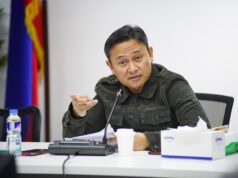Dams, water retention structure needed to address flooding — DoST

THERE is a need to apply Integrated Water Resource Management (IWRM), such as the creation of dams and water retention structures, to address the country’s perennial flooding problem, the Department of Science and Technology (DoST) said.
During the kickoff event of the National Science and Technology Week (NSTW) on Monday, DoST Secretary Renato U. Solidum, Jr., emphasized IWRM, a process that promotes the coordinated development of water, land, and related resources to address the public cry over flooding.
This involves the construction of flood-mitigating structures based on the land’s topography, the reforestation of watersheds, and the decongestion and dredging of waterways, Mr. Solidum said.
“So, part of the solution in the long term for climate change is to have dams (and) water retention structures,” Mr. Solidum told BusinessWorld on the sidelines of the NSTW kick-off event.
“It is so that we can capture the water instead of letting it cause flooding, and also make sure that we store the water for El Niño and other drought conditions,” he added.
The DoST Secretary also said that IWRM must be implemented according to the specific conditions of each of the 18 major river basins in the country and must be able to adapt to handle intense rainfall brought about by climate change.
Several agencies, such as the Department of Environment and Natural Resources (DENR) and the Department of Public Works and Highways (DPWH), are expected to implement these, Mr. Solidum said, with the DoST supporting them with scientific data.
“We now have the terrain model. We also provided NAMBREA (National Mapping and Resource Information Authority) with the LiDAR map,” he said.
NSTW 2025 LANDS IN ILOCOS REGION
Also on Monday, the DoST announced that this year’s NSTW will be held in Laoag City, Ilocos Norte, from Nov. 18 to 25, with a prime focus on “building smart and sustainable communities.”
“It means pushing the envelope towards an enabling environment to nurture and champion smart and sustainable business, communities, and governance by harnessing the power of science, technology, and innovation,” Maridon O. Sahagun, undersecretary for scientific and technical services, said during NSTW’s kick-off event.
This year’s NSTW is expected to feature four key technologies aimed at addressing challenges concerning human well-being, wealth creation, wealth protection, and sustainability.
Among the innovations is Project Delta, which uses artificial intelligence (AI), parallel computing, and other technologies to create hazard maps that can predict the impact of liquefaction and tsunamis. — Edg Adrian A. Eva



